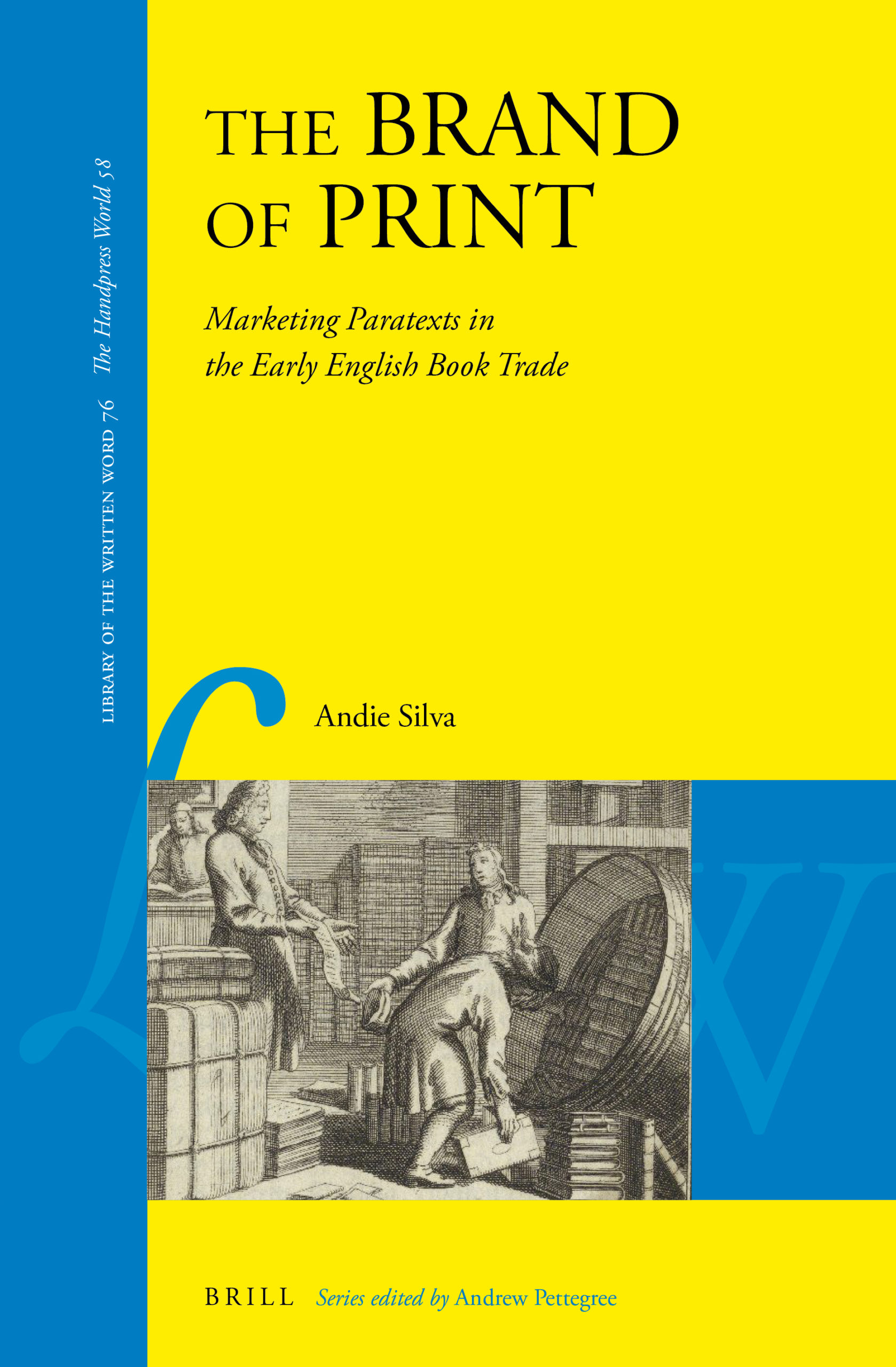Andie Silva, The Brand of Print: Marketing Paratexts in the Early English Book Trade (Brill: Boston, 2020) Hardback, ISBN: 978-90-04-41023-7.
In a year where bookcase credibility has become a crucial part of academic life, with towers of texts teetering into every Zoom call, Andie Silva’s insistence on the book as cultural commodity in this thought-provoking and innovative monograph is particularly resonant. From the introduction, the originality of Silva’s work becomes apparent as she productively combines contemporary marketing theory and book history. Sidestepping the focus upon the author found in Erne and Kastan, Silva places our attention firmly on “print agents” – a capacious term which here includes printers, publishers, editors, translators, stationers, and book sellers. By exploring the actions of these print agents through marketing theory, this wide-ranging, perceptive book draws together both market choices and cultural value, convincingly and cogently linking the commercial and rhetorical characteristics of the early modern marketplace of books and ideas. Silva challenges the distinctions that often stymie early modern book history: between reading for profit and reading for pleasure, literary and non-literary texts, canonical woks and printed ephemera, manuscript and print.
After a brief introduction, the first chapter explores how print agents engaged with systems of patronage. Silva frames dedicatory paratexts as a means for print agents to write themselves into networks of patronage, moving away from the customary focus on the author. She argues that print agents repeatedly demonstrated their cultural capital for readers by framing themselves as well-connected, diligent, and discerning, drawing extensively on Pierre Bordieu’s Distincition: A Social Critique of Taste (1679). This is continued in the second chapter, which argues that “affective branding” was deployed by print agents to convince readers that investing time, money, attention, and effort in a book would lead to a “profit” of cultural capital. Anyone who has spent time with early modern books will be used to the reoccurrence of phrases such as “very profitable” and “fit to be read”, emotive claims which Silva takes seriously. Silva makes a compelling case that in the book market “labour translates to care; pleasure to loyalty” (45) and that non-authorial paratexts, such as updated titles and corrections, work to create intimacy between ideal reader or consumer and the discerning print agent. However, the notion of “affective branding” was somewhat hazily sketched: as a reader unfamiliar with contemporary marketing practices, it was difficult to grasp the specific ways in which this branding works and forms relationships between agent and book buyer.
Visual branding and design provide the focus for the third chapter, with case studies examining the design of title pages, diagrams, and tables. Silva explores the pedagogical use of these visual elements in John Day and Adam Islip’s devotional works, which encourage readers to approach texts as repositories of knowledge to be repeatedly returned to. In doing so, print agents taught readers how to use books as “information technologies” (88). In the case of Thomas Archer, Silva proposes that his rather hodgepodge output (news pamphlets, new plays, reprints of best-sellers) was brought together and rationalised by a coherent visual language played out on the title-pages of his works. The fourth chapter attends to Queen Elizabeth’s translation, A Godly Meditation of the Soul, gifted to her stepmother Katherine Parr. Silva closely examines three print editions of the work: John Bale’s 1548 edition, James Cancellar’s 1580 text, and as part of Thomas Bentley’s weighty anthology of women’s writing, Monument of Matrons (1582). These three texts are used to explore how reading or, rather, book buying became a primary means of legitimising women’s devotion. Silva uses the paratextual devices of these print agents to illuminate how textual consumption provided a route for women to obtain cultural capital, providing or indicating textual, social and moral authority.
The fifth chapter tracks the publication and marketing of Thomas More’s Utopia over 150 years. Silva traces the development of “Utopia” as a brand: from a new term establishing itself on the market to an “iconic brand” with name recognition that could be reworked and co-opted. As in the previous chapter, by exploring how a text was reworked over generations, Silva provides compelling evidence of how print agents shaped the reading public, creating a market with specific, identifiable demands. In the case of Utopia, this is explicitly an English market, with the work playing a crucial role in the formation of national identity. The final chapter considers the labouring agents behind digital projects that mediate and re-mediate early modern books, with brief case studies of EEBO, BBTI, The Atlas of Early Printing, DEEP and EBBA. These demonstrate how born digital projects can reveal and hide the labour of digital agents, and should be a key resource for anyone designing or working upon a digital resource. However, the brevity of this chapter left this reader wanting more: Silva gestures towards some ideas for best practice but doesn’t fully delve into how digital projects can preserve complexity whilst still remaining legible.
In general, this is exciting, lucid work, that deftly moves through a wealth of different genres and print agents. Silva’s writing is perceptive and accessible and I can easily imagine many of the chapters, particularly the first and fifth, sitting well on undergraduate or masters level reading lists introducing students to the vital role that paratexts and book history can play in understanding both literary culture and social history. The Brand of Print will be a critical read for scholars working on early modern print culture as well as anyone interested in cultural history, print practices, or book history across periods.
Catherine R. Evans, University of York


